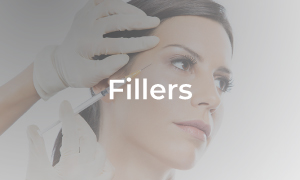Fillers
Fillers are gel-like substances that are injected beneath the skin to restore facial volume, smoothen lines and reduce wrinkles, or enhance facial contours. Fillers are common non-surgical treatments for facial rejuvenation.
There are two types of fillers: permanent fillers and temporary fillers. Permanent fillers are not biodegradable and stay in the body permanently. The long-term effects of permanent fillers are unpredictable. The removal of permanent fillers can be complicated, and complete removal is often impossible. The majority of fillers used currently are temporary fillers that are biodegradable. Temporary fillers are gradually broken down and leave the body through the natural biological process. Temporary fillers are generally safe and easy to use, with a high degree of safety and satisfactory results.
Fat grafting is another source of filler material that can be used to restore volume to the face, fill up deep lines and reduce facial wrinkles. Compared to fillers, fat graft generally feels softer. Since the source of fat graft is from the patient’s own body, the supply is usually unlimited. (see Fat Graft)
Common types of temporary fillers are:
-
-
-
Hyaluronic Acid (HA) Fillers. Currently, HA fillers are the most popular filler around. Hyaluronic acid is a form of an organic molecule that exists naturally in human body. Its primary function is to retain water in order to keep cells and tissues hydrated. Fillers made from HA have been used for many years and have good safety records. There are different types of HA fillers, depending on the size and structure of the HA molecule. High molecular weight HA fillers are thicker and stronger, ideal for injection into deeper structures to restore volume and provide tissue lifting. Low molecular weight HA fillers are usually thinner and softer and is more spreadable. They are ideal for superficial and delicate areas such as the lower eyelids and around the lips. Most HA fillers are prepared with lignocaine to help minimise discomfort during and after treatment. Depending on their molecular structures, different types of HA fillers can last from 6 months to 2 years. Examples of HA fillers are Juvederm™.
-
Calcium Hydroxylapatite (CaHa)Fillers. This group of fillers contains heavier and larger molecules, and they can stimulate the production of collagen. They are suitable for restoring volume in deeper structures and contouring certain facial features such as the nose and chin. The fillers generally last 12-18 months. An example of CaHa fillers is Radiesse™.
-
-
Applications of fillers:
-
-
-
Restore volume and provide lifting. Fillers can restore lost volume, such as in sunken cheeks and temples. They can also provide lifting to counter saggy skin and fill up deep lines such as tear trough, nasolabial folds, and marionette lines.
-
Improve skin texture. Hyaluronic acid fillers absorb water and retain water in the skin. The results are the restoration of hydration in the skin, reduce fine wrinkles, and make the skin appear more plump and radiant.
-
Sculpture facial features. Fillers can sculpt and augment facial features such as the nose, chin, cheekbones, lips and forehead to create the desired shapes and features.
-
-
Preparation
-
-
-
Inform the doctor of any pre-existing medical conditions and drug allergy. All medical conditions must be treated and stabilized before the procedure.
-
Stop smoking at least one week before the procedure. Smoking may diminish the results of filler.
-
Stop the following medications and supplements one week before the procedure:
-
All supplements containing vitamin E, ginseng, ginkgo, garlic, fish oil, and other ingredients increase bleeding during the procedure. Other supplements, traditional medicine, and herbs, in which elements are unknown, have to stop as well.
-
Medicine that increases bleeding during the procedure such as aspirin, NSAIDs, and warfarin. However, you may need to consult your physician who prescribed the medication before you stop them.
-
-
Procedure
Duration of Procedure: 5 to 15 min
Anaesthesia: Usually not necessary. Most of the fillers come with lignocaine which reduces pain and discomfort. Numb cream or cold compression can be applied for patients who are sensitive to pain.
Procedure: The doctor uses a fine needle to inject the filler into the target area to achieve the aesthetic goals.
Downtime: Usually no. Mild swelling minor bruises occur very rarely.
The onset of Results: immediate
Duration of action: 6 months to 2 years, depending on the type of filers.
Post Treatment Care
-
Avoid pressure on the treated area for at least one week
-
Avoid applying heat on the treated area for at least one week
-
Rarely there may be minor bruises at the treated area. If that happens usually they will resolve in a few days.





